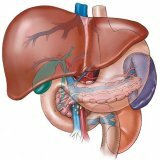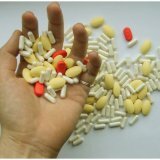Chronic liver disease

The elderly and alcohol abusers are usually the most affected. In this case, a relative increase in fat in the liver tissues and a decrease in important elements in the liver cells is observed.
Usually a violation of the functionality of the liver does not have any clinical manifestations. However, in conditions when in the process of vital activity the organism's requirements to this organ increase, manifestations of a long-term chronic disease are possible.
But recently, with such symptoms, children began to address themselves.
The main cause for such chronic diseases is a viral or bacterial infection, it is also possible that such a reaction is produced by worms that live directly in any organ.
What is chronic liver disease ?
Chronic inflammatory processes in the liver can be collectively called hepatitis. Typically, hepatitis is divided into several species. The most serious are diseases caused by viruses, for example, hepatitis A, B, D, and C. Typically, treatment of such liver diseases
is determined individually, given the degree of neglect, the physiological characteristics of the patient and, of course, the type of disease. Diagnosis is based on symptoms, and the final diagnosis is made based on the results of laboratory studies.Also, doctors note chronic liver diseases caused by the pathogenic flora present in the body of each person. Such are: cytomegalovirus, genital herpes and herpes simple. The cause of the development of pathogenic flora is the weakened state of the liver and the body as a whole, caused by the intake of antibiotics and chronic diseases of other organs, also caused by various microorganisms that produce toxins. Since the liver is one of the main "filters" of blood, most toxins pass through this organ and lead to weaken the liver and develop in it of various microorganisms and inflammations, which is the root cause of a chronic disease. Usually the main inflammatory processes pass in the bile ducts, various fungi, staphylococci, toxoplasma, streptococci, lamblia , etc. easily take root.
The result of such diseases are cholangitis in the bile duct and cholecystitis, dyskinesia, bends, constrictions in the gallbladder.
Usually, with such diseases, liver treatment is much more difficult, since it is not always possible to diagnose correctly by means of ultrasound and laboratory tests. The whole difficulty consists in the fact that several types of infections can become the cause, and during research, a very pathogenic flora is usually detected, at a time when the pathogenic flora acting on a specific organ becomes the cause of the disease. At the same time, in particularly difficult cases, it is not possible to take a tissue sample to determine pathologies. A test for the presence of each microorganism is simply physically impossible.
Treatment of
In the treatment of chronic liver diseases, an error is often made on its own, when the patient, knowing about the aggravation of the inflammatory process, tries to remove it with an antibiotic, which as a result does not give a positive effect. The reason is simple and trivial. If you have at least a minimum knowledge of antibiotics, you can determine that the spectrum of action of each drug is limited, and can only neutralize certain types of virus, bacteria or fungus. And since several kinds of microorganisms can become the cause of the chronic disease, which can not be destroyed by a single medicine - the effect is reduced to almost zero, while weakening the liver, making it more vulnerable. Also, by destroying one microorganism, we release the space for the development of the other, while allowing the viruses to penetrate deeper into the liver cells, that when they take the appropriate medicine they become simply inaccessible. Running liver diseases can eventually cause and concomitant diseases that will worsen the patient's condition, and also make treatment more difficult. Possible diseases include: bronchial asthma, allergy, inflammation of the pancreas, inflammatory processes in the intestine and stomach.
Homeopathy
Two methods are used to treat chronic liver diseases, which usually follow arcs after the other:
How in such cases do homoeopathic drugs work for chronic diseases? To explain the effect of such drugs, we return to the root cause of the disease - these are microorganisms and infections. Microorganisms are free to act when the body and the body as a whole are weakened and can not control and neutralize them. The reasons for this state are many, but the result is one. The goal of homeopathy is not to neutralize the cause of the disease directly, what antibiotics do, but to restore the normal functionality of the body and organ and thereby make double work. First, the body will be able to independently normalize the balance of beneficial and pathogenic organisms, and at the same time develop immunity to certain infections, preventing their occurrence in the future. When homeopathic preparations are used, the possibility of "concealment" of pathogenic organisms in cells is excluded, since the organ itself carries out "cleaning".



